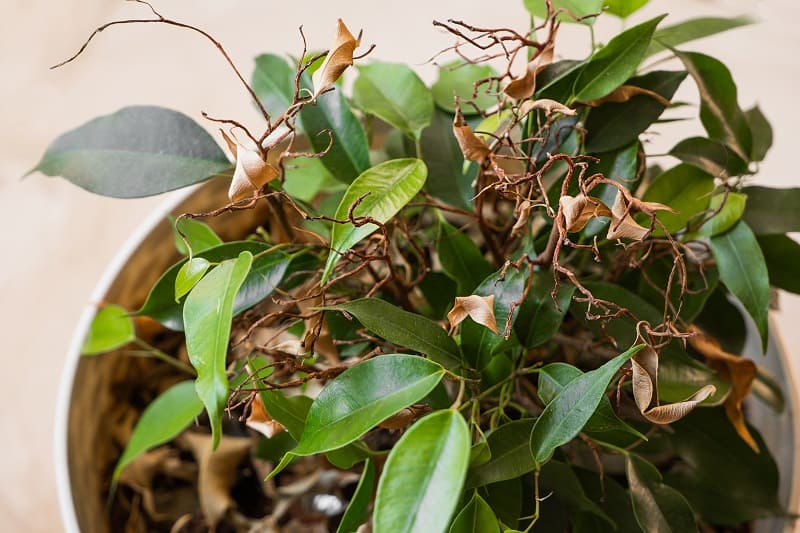
Droopy and yellowing leaves are a cause for concern for plant owners. It is an indication that something is not right with the plants. Despite a regular watering schedule, you may notice that your plants’ health continues to deteriorate. This article will help you determine whether your plants are overwatered or underwatered.
How To Tell If a Plant is Overwatered or Underwatered
You can tell whether a plant is overwatered or underwatered by feeling the leaves and the soil. Underwatered plants are dry and crisp to the touch, while overwatered plants are soft and droopy. Underwatered soil is dry and crusty, and overwatered soil is soggy. Either of these situations could be equally harmful to your plants, so there should be a fixed watering routine with just the right amount of water.
What are the symptoms of overwatered and underwatered plants?
These are the symptoms of overwatered and underwatered plants:
- Wilting – This is a symptom of both over- and underwatering, so always check the soil to determine which it is. Moist soil means it was due to overwatering, but dry soil means the wilted plant was overwatered.
- Browned edges – Like item one above, this is another symptom that could indicate either problem. Determine the cause by feeling the texture of the leaves. If they are crisp and light they are underwatered, but if they are soft and limp they are overwatered.
- Yellowing leaves – If the leaves are yellowing but also curling on the lower part it suggests underwatering, while yellowing and falling new growth is an indication of overwatering. To determine the real cause, check whether or not the soil is moist.
- Foul odor emanating from the soil – A foul odor from the soil is an indicator that the roots beneath are rotting because of overwatering.
- Mildew, mold or fungal growth – This is an indication of overwatering.
- Slow and stunted growth – If plants are growing slowly and unable to flower, it means that they are underwatered.
- Brittle and crisp stem – If stems are snapping and look brittle, your plants may be underwatered since healthy stems are strong and flexible.
- Soft and mushy stem – This indicates the presence of root rot in the soil due to overwatering. Root rot is characterized by slimy, mushy, black, grey or brown roots.
- Soil pulling away from the planter’s sides – This is an indication of underwatered plants.
- Dropping leaves – This is an indication of either overwatering or underwatering, so always check the moisture of the soil.
- Blisters on the leaves – The presence of blisters on the undersides of leaves may be an indication of burst plant cells due to overwatering.
- Pests – The presence of pests could indicate over- or under watering. Fruit flies and fungus gnats like moist conditions, suggesting overwatering, while spider mites prefer dry conditions, which may indicate underwatering.
How to avoid overwatering
These are the things you should do to avoid overwatering:
Always check the soil first.
Make sure to check each plant’s soil individually before watering it. You can do this by pushing your finger about two inches down into each planter to test for moisture. If the soil is dark and there is a bit of moisture, do not water. Plants only need water when the soil is light-colored and dry, although some plants may also have specific preferences, so it is always best to learn more about the plants you are cultivating.
Avoid watering the leaves.
Leaves that are often splashed with water could develop mold, so avoid getting leaves wet during watering. See to it that you water from the base of the plant.
Water the plants during daylight hours.
Ideally, plants should be watered when the sun is out so the moisture will evaporate easily. Watering at night time allows the soil to stay moist for a longer period, and this could encourage rot and fungus.
Ensure that planters and pots have drainage holes.
Drainage is vital to prevent overwatering of your plants. See to it that your plant pots have good drainage holes so excess water won’t get trapped. Overwatering could lead to a lack of oxygen. Also, root rot and fungus thrive in soil that is not drying out.
What should you do if you have overwatered your plants?
Here are some tips on what to do if you overwatered your plants:
- Be sure to remove any decaying leaves.
- Always refresh the roots and soil.
- Treat your plants with fungicide if there are signs of fungus or root rot.
- Wait for a week before watering the plants again.
Conclusion
Proper watering is essential for plants to survive. Plant owners sometimes have the misconception that consistent watering is the best option for their plants. To tell if a plant is overwatered or underwatered, the best thing to do is check the leaves and the soil.
Underwatered plants are crispy and dry to the touch, with crusty soil. Meanwhile, overwatered plants are soft and droopy and the soil is soggy.
Image: istockphoto.com / Aleksandra Pavlova